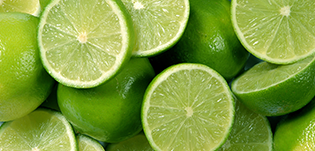Pucker up for today’s Food Friendzy featured ingredient! He’s Lime, and he’s ready to introduce you to all he has to offer in the kitchen.
Also known as: Limon, Citrus
Likes: Warm and sunny weather and plenty of water
Dislikes: What dislikes?
Hobbies: Juicing – the good kind
Find him: Adding fresh flavor to pies, “cooking” fish in ceviche, making marinades memorable
Pucker up for today’s Food Friendzy featured ingredient! He’s Lime, and he’s ready to introduce you to all he has to offer in the kitchen. This tart guy is part of the citrus family, and like his cousins, he’s always packing lots of flavor and nutrition. Sure, Orange gets all the attention as a handy and nutritious snack, but Lime has his own story and unique, stand out flavor.
Lime assumes you won’t be snacking on him like Orange, so the biggest benefits he offers are his flavor and a blast of vitamin C. Not only is vitamin C essential for a healthy immune system, but it also plays an important role in healthy skin and is showing promise in preventing certain kinds of cancer and boosting heart health.
His story is like so many others you’ve heard: fruit meets trader or explorer, trader or explorer takes fruit around the world, fruit becomes a beloved part of cuisines the world over. The big difference here is that out of Lime’s history came two very distinct Lime varieties, Key and Persian (also known as Tahitian). Key Limes have thin skin, are the smaller of the two varieties, and can be difficult to harvest.
Let’s not forget to mention… do you know how many little Key Limes it takes to make a pie?! Persian or Tahitian Limes are the more common variety these days and are larger with a thicker skin. They are much easier to harvest, if you’re lucky enough to have a tree, and can be prepped for whatever recipe you may have on the menu.
Here are some suggestions for making the most of Lime in your diet:
- Use Lime in place of salt and other high-sodium flavorings – Lime can actually enhance the flavor of foods similarly to salt but without adding any sodium. Take a cue from Latin American cuisines by skipping the salt and adding a splash of Lime juice to soups, vegetables, meats and seafood. Remember that just ¼ teaspoon of table salt contains about 600 mg of sodium.
- Skip the high-fat salad dressing – Lime doesn’t just stop at replacing salt and reducing your sodium intake. He can also cut fat and calories when you use him in place of salad dressings. Keep him handy for a quick squeeze, or request a couple of wedges of lime with your salad at restaurants.
- Add flavor to your water – Whether you’re trying to cut out high-calorie drinks or simply looking for tasty ways to hydrate during the day, a little Lime can go a long way. Try slicing a washed Lime and dropping him in your pitcher or bottle of water for a quick and flavorful drink during the day. While Limeade can be a fun treat on occasion, it can be high in sugar and calories, so stick to the water whenever you can.
- Do something unexpected with your fruits and veggies today – Many of us are looking for ways to add more fruits and vegetables into our diets, and Lime can help. Splash Lime juice on fresh grilled corn, sweet Mango slices, or any of your favorite summer fruits and veggies.

